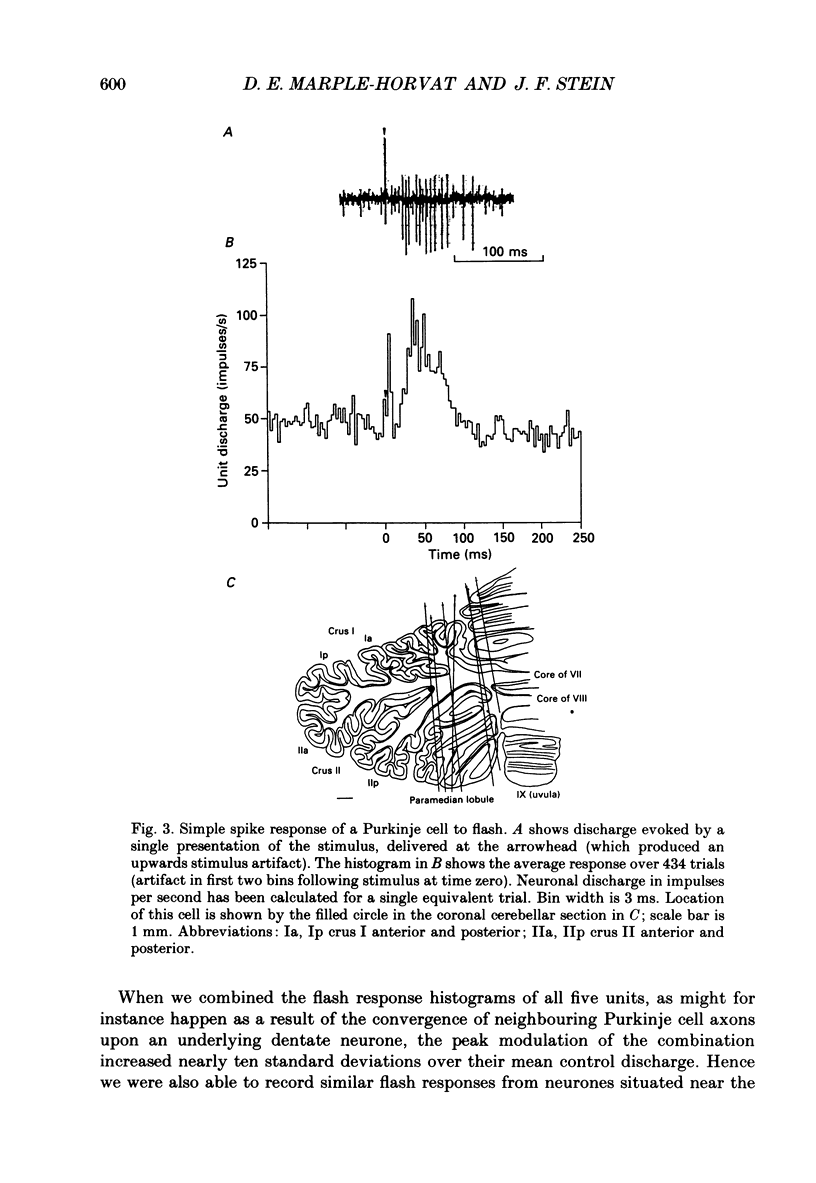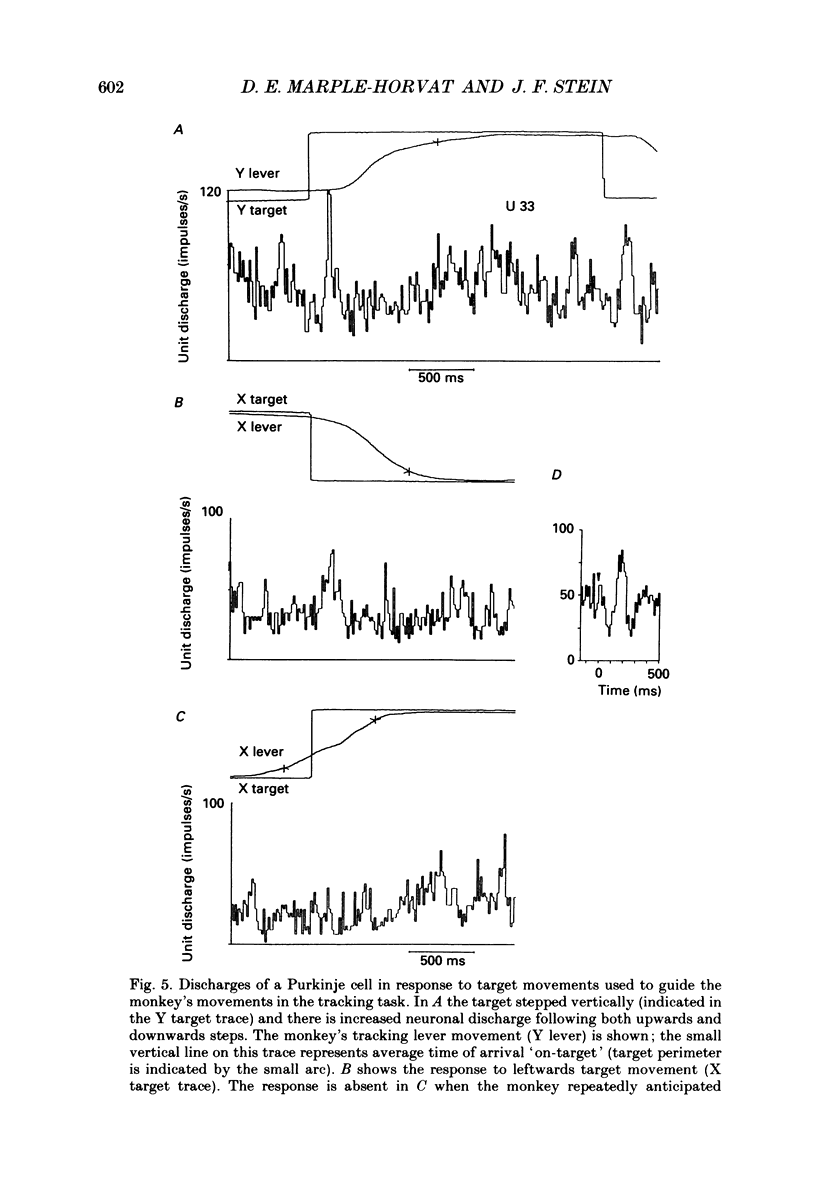Abstract
1. The responses of neurones in the lateral cerebellar cortex to visual stimuli and to eye movements were recorded in rhesus monkeys trained to perform visually guided arm and eye movements in a tracking task. 2. Twenty-two of 134 units recorded (16%) modulated their discharge in response to a bright Xenon flash. They were mainly located in the dorsal paraflocculus. Among those identified as Purkinje cells both simple spike and climbing fibre responses to the flash were seen. (72% of the units were related to arm movements; these were centred in the paramedian lobule, and have been described fully in Marple-Horvat & Stein (1987).) 3. The visual responsiveness of one of the units varied according to the phase of the monkey's task. Around the time that the target stepped, which was the monkey's cue to move, its sensitivity to other stimuli disappeared. 4. Only two neurones responded to the movements of the tracking target. These responses were conditional upon the monkey using visual signals to guide his movements; they did not respond to the target step if he moved before the target did. 5. Fourteen units (10%) located in crus I and II and lobulus simplex correlated strongly with the velocity of horizontal eye movements. Only one of these also responded to visual stimuli. 6. Thus most neurones were found to carry only visual, or eye movement, or limb movement information rather than combinations of these signals; they were located in different but overlapping regions of lateral cerebellar cortex. Visually responsive neurones are probably involved in planning the visual goal of movements, while eye and arm movement neurones probably help to create co-ordinative structures for executing voluntary eye and arm movements.
Full text
PDF



















Selected References
These references are in PubMed. This may not be the complete list of references from this article.
- Andersson G., Armstrong D. M. Complex spikes in Purkinje cells in the lateral vermis (b zone) of the cat cerebellum during locomotion. J Physiol. 1987 Apr;385:107–134. doi: 10.1113/jphysiol.1987.sp016487. [DOI] [PMC free article] [PubMed] [Google Scholar]
- Armstrong D. M. Functional significance of connections of the inferior olive. Physiol Rev. 1974 Apr;54(2):358–417. doi: 10.1152/physrev.1974.54.2.358. [DOI] [PubMed] [Google Scholar]
- Baker J., Gibson A., Glickstein M., Stein J. Visual cells in the pontine nuclei of the cat. J Physiol. 1976 Feb;255(2):415–433. doi: 10.1113/jphysiol.1976.sp011287. [DOI] [PMC free article] [PubMed] [Google Scholar]
- Beppu H., Suda M., Tanaka R. Analysis of cerebellar motor disorders by visually guided elbow tracking movement. Brain. 1984 Sep;107(Pt 3):787–809. doi: 10.1093/brain/107.3.787. [DOI] [PubMed] [Google Scholar]
- Bizzi E., Kalil R. E., Tagliasco V. Eye-head coordination in monkeys: evidence for centrally patterned organization. Science. 1971 Jul 30;173(3995):452–454. doi: 10.1126/science.173.3995.452. [DOI] [PubMed] [Google Scholar]
- Burne R. A., Mihailoff G. A., Woodward D. J. Visual corticopontine input to the paraflocculus: a combined autoradiographic and horseradish peroxidase study. Brain Res. 1978 Mar 17;143(1):139–146. doi: 10.1016/0006-8993(78)90757-6. [DOI] [PubMed] [Google Scholar]
- Chapman C. E., Spidalieri G., Lamarre Y. Activity of dentate neurons during arm movements triggered by visual, auditory, and somesthetic stimuli in the monkey. J Neurophysiol. 1986 Feb;55(2):203–226. doi: 10.1152/jn.1986.55.2.203. [DOI] [PubMed] [Google Scholar]
- Gellman R., Gibson A. R., Houk J. C. Inferior olivary neurons in the awake cat: detection of contact and passive body displacement. J Neurophysiol. 1985 Jul;54(1):40–60. doi: 10.1152/jn.1985.54.1.40. [DOI] [PubMed] [Google Scholar]
- Glickstein M., Cohen J. L., Dixon B., Gibson A., Hollins M., Labossiere E., Robinson F. Corticopontine visual projections in macaque monkeys. J Comp Neurol. 1980 Mar 15;190(2):209–229. doi: 10.1002/cne.901900202. [DOI] [PubMed] [Google Scholar]
- Harvey R. J., Porter R., Rawson J. A. The natural discharges of Purkinje cells in paravermal regions of lobules V and VI of the monkey's cerebellum. J Physiol. 1977 Oct;271(2):515–536. doi: 10.1113/jphysiol.1977.sp012012. [DOI] [PMC free article] [PubMed] [Google Scholar]
- Kase M., Miller D. C., Noda H. Discharges of Purkinje cells and mossy fibres in the cerebellar vermis of the monkey during saccadic eye movements and fixation. J Physiol. 1980 Mar;300:539–555. doi: 10.1113/jphysiol.1980.sp013178. [DOI] [PMC free article] [PubMed] [Google Scholar]
- Marple-Horvat D. E., Stein J. F. Cerebellar neuronal activity related to arm movements in trained rhesus monkeys. J Physiol. 1987 Dec;394:351–366. doi: 10.1113/jphysiol.1987.sp016874. [DOI] [PMC free article] [PubMed] [Google Scholar]
- May J. G., Keller E. L., Suzuki D. A. Smooth-pursuit eye movement deficits with chemical lesions in the dorsolateral pontine nucleus of the monkey. J Neurophysiol. 1988 Mar;59(3):952–977. doi: 10.1152/jn.1988.59.3.952. [DOI] [PubMed] [Google Scholar]
- Miall R. C., Weir D. J., Stein J. F. Visuo-motor tracking during reversible inactivation of the cerebellum. Exp Brain Res. 1987;65(2):455–464. doi: 10.1007/BF00236319. [DOI] [PubMed] [Google Scholar]
- Miles F. A., Fuller J. H., Braitman D. J., Dow B. M. Long-term adaptive changes in primate vestibuloocular reflex. III. Electrophysiological observations in flocculus of normal monkeys. J Neurophysiol. 1980 May;43(5):1437–1476. doi: 10.1152/jn.1980.43.5.1437. [DOI] [PubMed] [Google Scholar]
- Mountcastle V. B., Lynch J. C., Georgopoulos A., Sakata H., Acuna C. Posterior parietal association cortex of the monkey: command functions for operations within extrapersonal space. J Neurophysiol. 1975 Jul;38(4):871–908. doi: 10.1152/jn.1975.38.4.871. [DOI] [PubMed] [Google Scholar]
- Noda H., Mikami A. Discharges of neurons in the dorsal paraflocculus of monkeys during eye movements and visual stimulation. J Neurophysiol. 1986 Oct;56(4):1129–1146. doi: 10.1152/jn.1986.56.4.1129. [DOI] [PubMed] [Google Scholar]
- Ron S., Robinson D. A. Eye movements evoked by cerebellar stimulation in the alert monkey. J Neurophysiol. 1973 Nov;36(6):1004–1022. doi: 10.1152/jn.1973.36.6.1004. [DOI] [PubMed] [Google Scholar]
- Stein J. F. Role of the cerebellum in the visual guidance of movement. Nature. 1986 Sep 18;323(6085):217–221. doi: 10.1038/323217a0. [DOI] [PubMed] [Google Scholar]
- Strick P. L. The influence of motor preparation on the response of cerebellar neurons to limb displacements. J Neurosci. 1983 Oct;3(10):2007–2020. doi: 10.1523/JNEUROSCI.03-10-02007.1983. [DOI] [PMC free article] [PubMed] [Google Scholar]
- Suzuki D. A., Keller E. L. Visual signals in the dorsolateral pontine nucleus of the alert monkey: their relationship to smooth-pursuit eye movements. Exp Brain Res. 1984;53(2):473–478. doi: 10.1007/BF00238178. [DOI] [PubMed] [Google Scholar]


